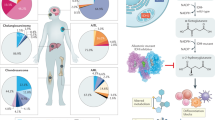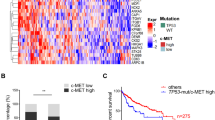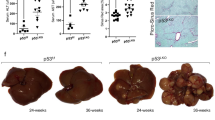Abstract
The mannose 6-phosphate/insulin-like growth factor-II receptor (M6P/IGF2R) functions in the intracellular trafficking of lysosomal enzymes1, the activation of the potent growth inhibitor, transforming growth factor β2, and the degradation of IGF2 (ref. 1), a mitogen often overproduced in tumours3–6. We have recently shown that 70% of human hepatocellular tumours have loss of heterozygosity (LOH) at the M6P/IGF2R locus7 which maps to chromosome 6q26–q27 (ref. 8). Using a coarse screen, we have now identified point mutations in the remaining allele of 25% of human hepatocellular carcinomas (HCCs) with LOH. These mutations give rise to truncated receptor protein and significant amino acid substitutions, and provide evidence that the M6P/IGF2R gene functions as a tumour suppressor in human liver carcinogenesis.
This is a preview of subscription content, access via your institution
Access options
Subscribe to this journal
Receive 12 print issues and online access
$209.00 per year
only $17.42 per issue
Buy this article
- Purchase on SpringerLink
- Instant access to full article PDF
Prices may be subject to local taxes which are calculated during checkout
Similar content being viewed by others
References
Kornfeld, S. Structure and function of the mannose 6-phosphate/insulin-like growth factor II receptors. A. Rev. Biochem. 61, 307–330 (1992).
Dennis, P.A. & Rifkin, D.B. Cellular activation of latent transforming growth factor β requires binding to the cation-independent mannose 6-phosphate/insulin-like growth factor type II receptor. Proc. natn. Acad. Sci. U.S.A. 88, 580–584 (1991).
Yang, D. & Rogler, C.E. Analysis of insulin-like growth factor II (IGF-II) expression in neoplastic nodules and hepatocellular carcinomas of woodchucks utilizinging in situ hybridization and immunocytochemistry. Carcinogenesis 12, 1893–1901 (1991).
Osbome, O.K. et al. Insulin-like growth factor II (IGF-II): a potential autocrine/paracrine growth factor for human breast cancer acting via the IGF-I receptor. Molec. Endocr. 3, 1701–1709 (1989).
Chrislofori, G., Nalk, P. & Hanahan, D.A. second signal supplied by insilin like growth factor ll in oncogene-induced tumorigenesis. Nature 369, 414–417 (1994).
Singer, C. et al. Malignant breast epithelium selects for insulin-like growth factor II expression in breast stroma: evidence for paracrine function. Cancer Res. 55, 2448–2454 (1995).
De Souza, A.T. et al. Frequent loss of heterozygosity on 6q at the mannose 6-phosphate/msutin-like growth factor II receptor locus in human hepatocellular tumors. Oncogene 10, 1725–1729 (1995).
Laureys, G., Barton, D.E., Ullrich, A. & Francke, U. Chromosomal mapping of the gene for the type II insulin-like growth factor receptor/cation-independent mannose 6-phosphate receptor in man and mouse. Genomics 3, 224–229 (1988).
Szebenyi, G. & Rotweni, P. The mouse insulin-like growth factor ll/catton-hdeperident mannose 6-phosphate (IGF-ll/MPR) receptor gene: molecular cloning and genomfc organization. Genomics 19, 120–129 (1994).
Horowitz, D.S. & Krainer, A.R. Mechanisms for selecting 5′ splice sites in mammalian pre-mRNA splicing. Trends Genet. 10, 100–106 (1994).
Padgett, R.A., Grabowski, P.J., Konarska, M.M., Seiler, S. & Sharp, P.A. Splicing of messenger RNA precursors. A. Rev. Biochem. 55, 1119–1150 (1986).
Wang, Z.-Q., Fung, M.R., Barbw, D.P. & Wagner, E. Regulation of embryonic growth and lysosomal targeting by the imprinted IGF2/Mpr gene. Nature 372, 464–467 (1994).
Hartshorn, M.A., Scott, C.D. & Baxter, R.C. Immunofluorescent localization of type II insulin-like growth factor receptor in rat liver and hepatoma cells. J. Endocr. 121, 221–227 (1988).
Westlund, B., Dahms, N.M. & Kornfeld, S. The bovine mannose 6-phosphate/insulin-like growth factor II receptor, localization of mannose 6-phosphate binding sites to domains 1–3 and 7–11 of the extra cytoplasmic region. J. biol. Chem. 266, 23233–23239 (1991).
Dahms, N.M., Rose, R.A., Molkentin, J.D., Zhang, Y. & Brzycki, M.A. The bovine mannose 6-phosphate/insulin-like growth factor II receptor, the role of arginine residues in mannose 6-phosphate binding. J. biol. Chem. 268, 5457–5463 (1993).
Dahms, H.M., Wick, D.A. & Brzycki-Wessell, M.A. The bovine mannose 6-phosphate/insulin-like growth factor II receptor localization of the insulin-like growth factor II binding site to domains 5–11. J. biol. Chem. 289, 3802–3809 (1994).
Barlow, D.R., Stöger, R., Herrmann, B.G., Saito, K. & Schweifer, N. The mouse insulin-like growth factor type-2 receptor is imprinted and closely linked to the Tme locus. Nature 349, 84–87 (1991).
Xu, Y., Goodyer, C.G., Deal, C. & Polychronakos, C. Functional polymorphism in the parental imprinting of the human IGF2R gene. Biochem. biophys. Res. Commun. 197, 747–754 (1993).
Kalecheuer, V.M., Mariman, E.G., Schepens, M.T., Rehder, H. & Ropers, H.-H. The insulin-like growth factor type-2 receptor gene is imprinted in the mouse but not in humans. Nature Genet. 5, 74–78 (1993).
Ogawa, O., McNoe, L.A., Eccles, M.R., Morison, I.M. & Reeve, A.E. Human insulin-like growth factor type I and type II receptors are not imprinted. Hum. molec. Genet. 2, 2163–2165 (1993).
Causin, C. et al. Mannose 6-phosphate/insulin-like growth factor ll-binding proteins in human serum and urine, their relation to the mannose 6-phosphate/insulin-like growth factor II receptor. Biochem. J. 252, 795–799 (1988).
Jirtle, R.L., Hankins, G.R., Reisenbichler, H. & Boyer, I.J. Regulation of mannose 6-phosphate/insulin-like growth factor-ll receptors and transforming growth factor beta during liver tumor promotion with phenobarbital. Cartinogenesis 15, 1473–1478 (1994).
Author information
Authors and Affiliations
Rights and permissions
About this article
Cite this article
De Souza, A., Hankins, G., Washington, M. et al. M6P/IGF2R gene is mutated in human hepatocellular carcinomas with loss of heterozygosity. Nat Genet 11, 447–449 (1995). https://doi.org/10.1038/ng1295-447
Received:
Accepted:
Issue Date:
DOI: https://doi.org/10.1038/ng1295-447
This article is cited by
-
Upregulation of IGF2R evades lysosomal dysfunction-induced apoptosis of cervical cancer cells via transport of cathepsins
Cell Death & Disease (2019)
-
Maternal transmission of an Igf2r domain 11: IGF2 binding mutant allele (Igf2rI1565A) results in partial lethality, overgrowth and intestinal adenoma progression
Scientific Reports (2019)
-
IGF and mTOR pathway expression and in vitro effects of linsitinib and mTOR inhibitors in adrenocortical cancer
Endocrine (2019)
-
Inhibition of the IGF signaling pathway reverses cisplatin resistance in ovarian cancer cells
BMC Cancer (2017)
-
Recurrent mutation of IGF signalling genes and distinct patterns of genomic rearrangement in osteosarcoma
Nature Communications (2017)



